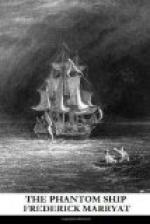It was a beautiful sight, to behold the blue rippling sea, covered with nearly six hundred of these picturesque craft, all under sail, and darting through the water like dolphins in pursuit of prey; all crowded with natives, whose white dresses formed a lively contrast with the deep blue of the water. The large peroquas, in which were Philip and Krantz with the native commanders, were gaily decorated with streamers and pennons of all colours, that flowed out and snapped with the fresh breeze. It appeared rather to be an expedition of mirth and merriment, than one which was proceeding to bloodshed and slaughter.
On the evening of the second day they had made the island of Tidore, and run down to within a few miles of the Portuguese factory and fort. The natives of the country, who disliked, though they feared to disobey the Portuguese, had quitted their huts near the beach and retired into the woods. The fleet, therefore, anchored and lay near the beach, without molestation, during the night. The next morning Philip and Krantz proceeded to reconnoitre.
The fort and factory of Tidore were built upon the same principle as almost all the Portuguese defences in those seas. An outer fortification, consisting of a ditch, with strong palisades embedded in masonry, surrounded the factory and all the houses of the establishment. The gates of the outer wall were open all day for ingress and egress, and closed only at night. On the seaward side of this enclosure was what may be termed the citadel or real fortification; it was built of solid masonry with parapets, was surrounded by a deep ditch, and was only accessible by a drawbridge, mounted with cannon on every side. Its real strength however, could not well be perceived, as it was hidden by the high palisading which surrounded the whole establishment. After a careful survey, Philip recommended that the large peroquas with the cannon should attack by sea, while the men of the small vessels should land and surround the fort—taking advantage of every shelter which was afforded them, to cover themselves while they harassed the enemy with their matchlocks, arrows, and spears. This plan having been approved of, one hundred and fifty peroquas made sail; the others were hauled on the beach, and the men belonging to them proceeded by land.




